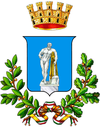Ercolano
| Ercolano | ||
|---|---|---|
| Comune | ||
| Metropolitan City of Naples | ||

Panorama of Ercolano
|
||
|
||
| Location of Ercolano in Italy | ||
| Coordinates: 40°48′N 14°21′E / 40.800°N 14.350°E | ||
| Country | Italy | |
| Region | Campania | |
| Frazioni | San Vito | |
| Government | ||
| • Mayor | Ciro Buonajuto | |
| Area | ||
| • Total | 19.64 km2 (7.58 sq mi) | |
| Elevation | 44 m (144 ft) | |
| Population (30 June 2015) | ||
| • Total | 53,843 | |
| • Density | 2,700/km2 (7,100/sq mi) | |
| Demonym(s) | Ercolanesi | |
| Time zone | CET (UTC+1) | |
| • Summer (DST) | CEST (UTC+2) | |
| Postal code | 80056 | |
| Dialing code | 081 | |
| Patron saint | Assumption of Mary | |
| Saint day | August 15 | |
| Website | Official website | |
Ercolano [erkoˈlaːno] is a town and comune in the Metropolitan City of Naples, Campania of southern Italy. It lies at the western foot of Mount Vesuvius, on the Bay of Naples, just southeast of the city of Naples. The medieval town of Resina - read Resìna - was built on the volcanic material left by the eruption of Vesuvius (79 CE) that destroyed the ancient city of Herculaneum, from which the present name is derived. Ercolano is a resort and the starting point for excursions to the excavations of Herculaneum and for the ascent of Vesuvius by bus. The town also manufactures leather goods, buttons, glass, and the wine known as Lacryma Christi (Tears of Christ).
In legend, Herculaneum was founded by Hercules returning from one of his Twelve Labours. Historically, it was most likely founded by the Oscans, an Italic tribe of the 8th century BC, and later became part of both the Etruscan and Samnite dominions. Under the control of the Romans, the city was a renowned seaside resort where some of the richest Roman citizens spent their summer vacations. It was built according to the standard model of Hippodamus of Miletus with a grid of crossing Decumans and Cardos. The houses are elegant and large and there are public buildings that are abundant and large compared to the small number of inhabitants (about 5,000).
In AD 62 the town suffered major damage from a violent earthquake and restoration works were still going on when on 24 August of AD 79 Mt. Vesuvius erupted and completely buried the city under a deep layer of hot mud and other volcanic material. Unlike neighboring Pompeii, the citizens of Herculaneum died of thermal shock from the extremely hot pyroclastic surges, rather than buried under heavy ash.
...
Wikipedia


